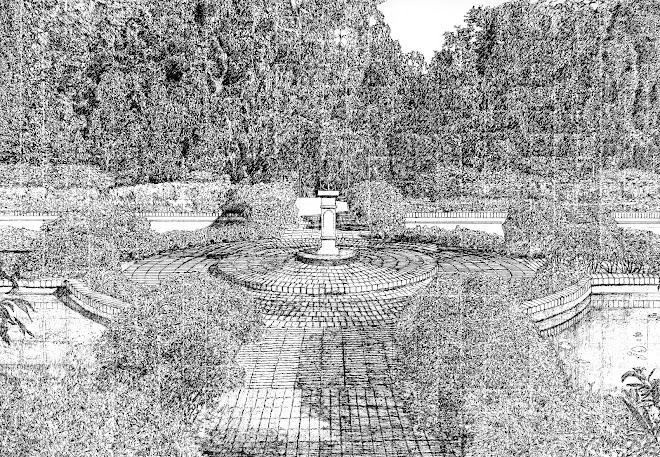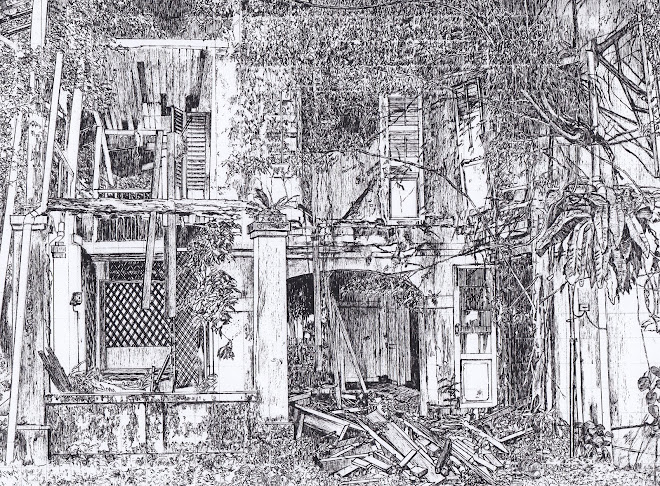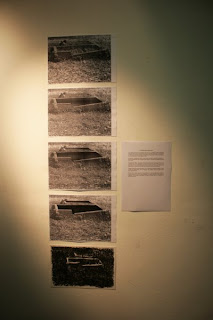
Joss paper furnace. (Circle)

Firewood. (Triangle)

Mu. (Square)
I ask myself: How do these drawings come about? Why did I create these drawings?
I did not create these drawings as a response to Sengai’s Circle-Triangle-Square painting. (Note: Sengai’s painting is read from right to left.) In fact, these drawings were done separately over a period of about twenty months and they were not done in the Circle-Triangle-Square sequence.
Triangle (Feb 2007)
I was reading Dogen’s Shobogenzo and these drawings were influenced by some of the things I had read:
Once firewood is reduced to ashes, it cannot return to firewood.
Long ago, a monk approached Daisho Koshuki and asked, “What is the original Buddha Mind?” He replied, “Wall, fence, tiles, stones.”
Of my three drawings, I did the drawing of the firewood first. I saw the pile of firewood in a Hindu temple, and it took me four hours to complete the drawing.
Square (Nov 2007)
While most of my drawings were done plein-air or worked from photographs, the wall is a drawing done entirely from memory and imagination. According to the Shobogenzo, the wall symbolises “everyday mind” – life and death, coming and going enter freely. I had hidden the word mu in my drawing. Mu translates into emptiness or nothingness in the Buddhist context.
Before I continue the discussion of my drawings, I need to talk about Ozu. Yasujiro Ozu (1903 – 1963) is a Japanese film-maker famous for works such as Tokyo Story, Late Spring, and Equinox Flowers. I was inspired by Ozu’s films, especially Late Spring. The story is about a father who wants his daughter to get married. In a moving scene, the father and his friend discuss the vicissitudes of life and shortly after, the camera films the Zen garden and the white quadrilateral space of the garden fills the screen. To me, the whiteness and emptiness fully capture the idea of mu. In that three seconds or less, I felt I had completely understood what Ozu was trying to express. Back to the story, the daughter eventually marries, and the father would live his final days in solitude.
In his essay Two or three things I know about Yasujiro Ozu, Jim Jarmusch, director of Stranger than Paradise, mentioned that Ozu’s grave has no name and no date of birth or death on it. Instead there is only the single Chinese character mu.
Circle (Nov 2008)
The circle (or enso) is a recurring motif in Zen painting (See Enso: Zen Circles of Enlightenment by Audrey Yoshiko Seo).
When I was in university, I was interested in Zen Buddhism and I discovered the works of Zen painter Sengai. Of these, the Circle-Triangle-Square is one of the hardest to grasp. Zen scholar Daisetsu Teitaro Suzuki interpreted it to mean the universe. In those days, I never really thought about describing the universe in a shape (be it a circle, square, or triangle) until I saw how Ozu filmed the Zen Garden in Late Spring.
How does one describe the universe or other big words like ‘infinity’, ‘life’ etc. in a line, a shape, or a colour? It is entirely up to the artist. Even mathematicians have a mathematical symbol (∞) to express the concept of infinity, and quantum physicists have tried to quantify the universe in various equations.
Zen, however, is not concerned with the physical universe in a scientific way. All heaven and earth, all life and death, is present in each moment, symbolised by something as seemingly insignificant as a sneeze. Dogen wrote in Shobogenzo (see the Shinjingakudo chapter):
For me, a sudden and unexpected sneeze is like an echo that symbolises the instantaneous co-existence of life and death, heaven and earth in each moment. The entire content and meaning of heaven and earth and its relationship to the mind reduces itself to one eternal moment.
The circle in Zen therefore does not describe the physical world or universe. Instead, I think it symbolises everyday existence, the cyclical seasons, life cycles, hydrological cycle etc., and the Buddhist belief in reincarnation and cyclical existence. Hence the circle symbolises all of life and the universe itself.
In 2008, I saw the joss paper furnace after I wandered aimlessly into a Taoist temple. What attracted me most was the circle. When I was looking at the ashes in the brick furnace, what I saw was the reality of death in the cycle of life. That was the reason why I had chosen to draw the furnace instead of all the other objects in the temple. I took a few photographs of the furnace and worked from them. The drawing took me about six hours.
Circle-Triangle-Square
When you put these ideas together, it becomes clear how my drawings were influenced by Dogen, Ozu, and Sengai. I return to the beginning: I did not produce these drawings with the intention of having a discourse with Sengai, Dogen or Ozu. However, I think it is important for my audience to understand that these people have influenced the way I view the world.
To be honest, even after completing the three drawings, I saw them as separate drawings until I was compiling my drawings for a second book which I am working on. The tentative title of the book is Sorrowful World, the earthly plane of death and rebirth from which Buddhists seek release. I was thinking of having two drawings for the cover, and it was then that I thought my wall and furnace drawings might relate to each other because both drawings are of bricks and they share the themes of impermanence and nothingness. At that time, I had already noticed that one is a ‘square’ and the other is a ‘circle’, but it was only months later that I thought my drawing of firewood could be a ‘triangle’ to complete the discourse between the three drawings. These drawings could also begin a discourse with Sengai’s work and the other Zen influences.
The art, therefore, cannot be reduced to my drawings or this writing alone, or the Zen influences. I have put all this information together as one work in this exhibition, and the art is the discourse between this work and the audience. Only when this is understood, then the Circle-Triangle-Square discourse is complete.


















